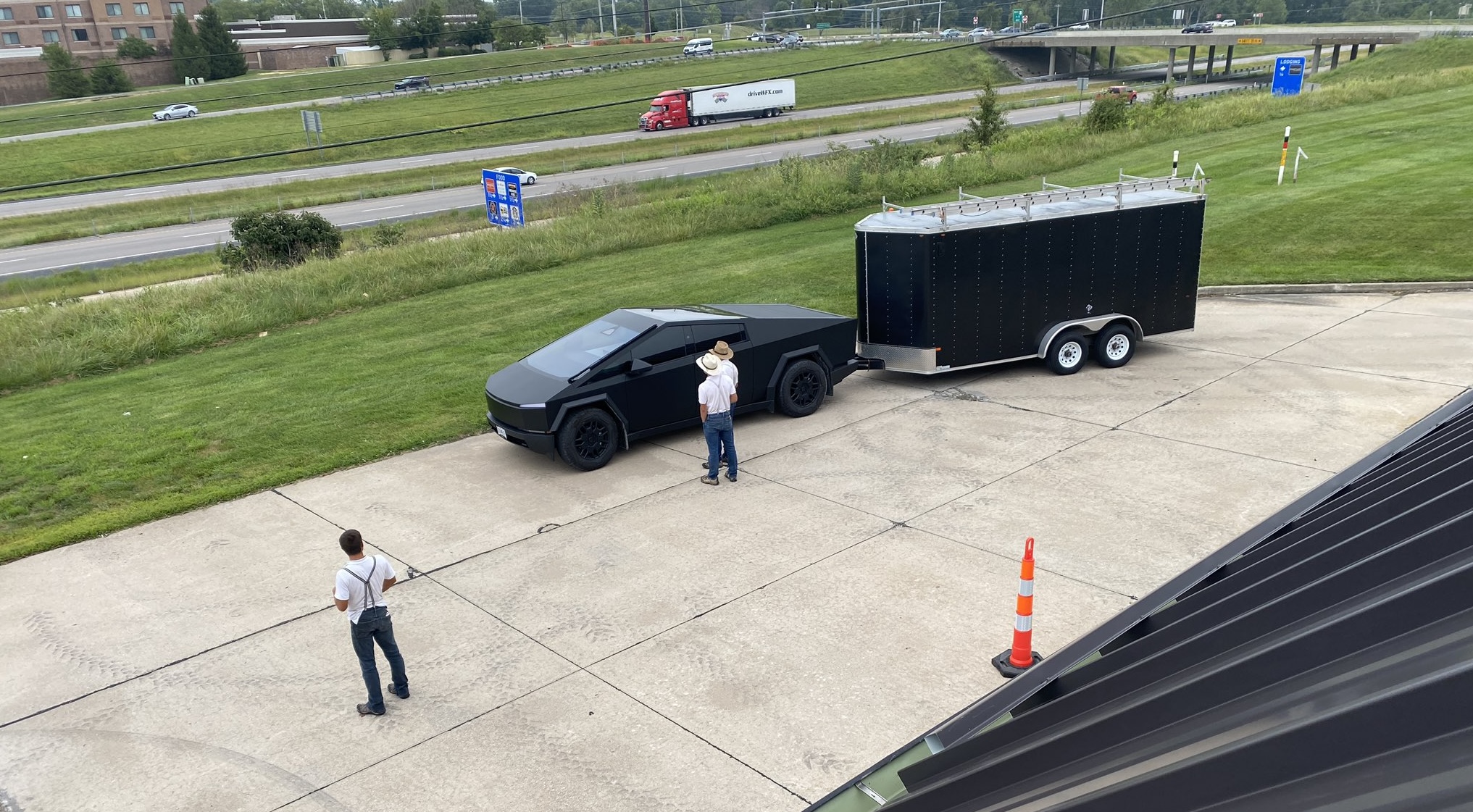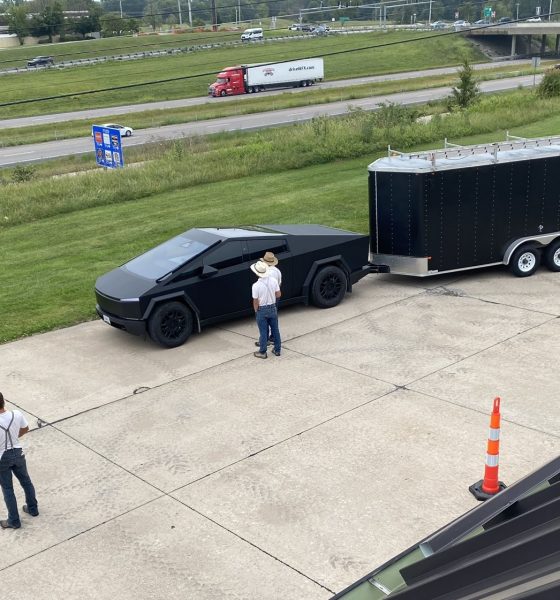

News
Tesla owner reports almost $65/day fuel savings after using Cybertruck to tow construction trailer
A Tesla owner and contractor in Missouri recently shared an observation on social media that stunned several members of the electric vehicle community. As per the Tesla owner, he is currently saving almost $65 per day on fuel costs just by using his Cybertruck to tow his construction trailer.
Dan Burke, who operates White Wolf Construction & Home Inspection, shared his experience in a post on social media platform X. As per the Tesla owner, the Cybertruck has become his around-town tow vehicle for his construction trailer. Even if the Cybertruck’s range is reduced by the trailer, the vehicle’s range is still enough for his day-to-day needs. Overall, the Tesla owner noted that the Cybertruck saves him almost $65 per day in fuel savings alone.
Cybertruck doing the work . It’s replaced my Ram as the around town tow vehicle for the construction trailer. Even with reduced range, most of my trips are 15-20 miles each way a few times a day. Saves me almost $65 a day in fuel!! pic.twitter.com/cv9aVWxu9q— Dan Burke (@DeBergo) August 13, 2024
The Tesla owner’s post unsurprisingly caught a lot of attention on social media, with skeptics doubting the Cybertruck owner’s claims. As per Burke, however, his daily fuel savings are so high because his previous around-town tow vehicle, a Dodge Ram, had a number of performance mods and a dedicated towing tune, resulting in the pickup truck requiring premium fuel and getting only 9 mpg. Thus, on a typical day, Burke noted that he would spend about $70 on fuel for his Dodge Ram.
Love seeing how people are using their Cybertruck to save money. As a bonus it's also fun to drive when not being used for work https://t.co/mixUqc8Iix— Wes (@wmorrill3) August 14, 2024
With the Cybertruck, the Tesla owner noted that his fueling costs are significantly lower. Burke noted that he charges his Cybertruck at home, where off-peak power rates are at 4.5 cents per kWh. This results in daily fuel savings of about $65, or about $325 per week on a five-week workday. Estimated savings on a regular 20-day month would be about $1,300, and since a common year is comprised of 260 work days, the Tesla owner’s annual fuel savings could reach up to $16,900.
$65 a DAY in fuel savings….
That’s dudes cybertruck payment, paid for…. In FUEL SAVINGS.
EV trucks are a no brainer for 95% of the truck population. https://t.co/bALSTK8iCG— Greggertruck (@greggertruck) August 13, 2024
“That’s how much gas I put in my Ram almost every day when I pull this trailer. It weighs 6300-ish pounds on a normal day, and the Ram gets right at 9 mpg pulling it. The Ram has a bunch of performance mods, which is great for power but sucks down fuel. Premium fuel no less because of the towing tune I run on it. The Cybertruck is averaging 675 wh/mi on the same drive if I stay off the highway. On the highway, it’s around 824-875 depending on wind. So on a typical day, 160 miles /9mpg x 3.95 = $70. If I charge at my house, off-peak it’s 4.5 cents a kWh. 100 kWh back to the battery at 4.5 cents and that’s about $65 a day in savings,” Burke explained in a post on X.
Buying a cybertruck for a work truck is a no brained. You save on fuel, maintenance and it’s fast and fun to drive on top of that.— Dan Burke (@DeBergo) August 14, 2024
Granted, one could argue that Burke is a special case since his business needs fit perfectly with the Cybertruck’s current capabilities, but one could also argue that there are a lot of business owners that could see comparable benefits today just by using Tesla’s all-electric pickup truck. There are a lot of enterprises, after all, whose operations are centered on short to medium distance towing. For these, the Cybertruck seems like a very valid viable choice today, even if Tesla is still exclusively producing Foundation Series variants for customers.
Don’t hesitate to contact us with news tips. Just send a message to simon@teslarati.com to give us a heads up.

News
Tesla China delivery centers look packed as 2025 comes to a close
Needless to say, it appears that Tesla China seems intent on ending 2025 on a strong note.

Tesla’s delivery centers in China seem to be absolutely packed as the final days of 2025 wind down, with photos on social media showing delivery locations being filled wall-to-wall with vehicles waiting for their new owners.
Needless to say, it appears that Tesla China seems intent on ending 2025 on a strong note.
Full delivery center hints at year-end demand surge
A recent image from a Chinese delivery center posted by industry watcher @Tslachan on X revealed rows upon rows of freshly prepared Model Y and Model 3 units, some of which were adorned with red bows and teddy bears. Some customers also seem to be looking over their vehicles with Tesla delivery staff.
The images hint at a strong year-end push to clear inventory and deliver as many vehicles as possible. Interestingly enough, several Model Y L vehicles could be seen in the photos, hinting at the demand for the extended wheelbase-six seat variant of the best-selling all-electric crossover.
Strong demand in China
Consumer demand for the Model Y and Model 3 in China seems to be quite notable. This could be inferred from the estimated delivery dates for the Model 3 and Model Y, which have been extended to February 2026 for several variants. Apart from this, the Model Y and Model 3 also continue to rank well in China’s premium EV segment.
From January to November alone, the Model Y took China’s number one spot in the RMB 200,000-RMB 300,000 segment for electric vehicles, selling 359,463 units. The Model 3 sedan took third place, selling 172,392. This is quite impressive considering that both the Model Y and Model 3 are still priced at a premium compared to some of their rivals, such as the Xiaomi SU7 and YU7.
With delivery centers in December being quite busy, it does seem like Tesla China will end the year on a strong note once more.
News
Tesla Giga Berlin draws “red line” over IG Metall union’s 35-hour week demands
Factory manager André Thierig has drawn a “red line” against reducing Giga Berlin’s workweek to 35 hours, while highlighting that Tesla has actually increased its workers’ salaries more substantially than other carmakers in the country.

Tesla Giga Berlin has found itself in a new labor dispute in Germany, where union IG Metall is pushing for adoption of a collective agreement to boost wages and implement changes, such as a 35-hour workweek.
In a comment, Giga Berlin manager André Thierig drew a “red line” against reducing Giga Berlin’s workweek to 35 hours, while highlighting that Tesla has actually increased its workers’ salaries more substantially than other carmakers in the country.
Tesla factory manager’s “red line”
Tesla Germany is expected to hold a works council election in 2026, which André Thierig considers very important. As per the Giga Berlin plant manager, Giga Berlin’s plant expansion plans might be put on hold if the election favors the union. He also spoke against some of the changes that IG Metall is seeking to implement in the factory, like a 35-hour week, as noted in an rbb24 report.
“The discussion about a 35-hour week is a red line for me. We will not cross it,” Theirig said.
“(The election) will determine whether we can continue our successful path in the future in an independent, flexible, and unbureaucratic manner. Personally, I cannot imagine that the decision-makers in the USA will continue to push ahead with the factory expansion if the election results favor IG Metall.”
Giga Berlin’s wage increase
IG Metall district manager Jan Otto told the German news agency DPA that without a collective agreement, Tesla’s wages remain significantly below levels at other German car factories. He noted the company excuses this by referencing its lowest pay grade, but added: “The two lowest pay grades are not even used in car factories.”
In response, Tesla noted that it has raised the wages of Gigafactory Berlin’s workers more than their German competitors. Thierig noted that with a collective agreement, Giga Berlin’s workers would have seen a 2% wage increase this year. But thanks to Tesla not being unionized, Gigafactory Berlin workers were able to receive a 4% increase, as noted in a CarUp report.
“There was a wage increase of 2% this year in the current collective agreement. Because we are in a different economic situation than the industry as a whole, we were able to double the wages – by 4%. Since production started, this corresponds to a wage increase of more than 25% in less than four years,” Thierig stated.
News
Tesla is seeing a lot of momentum from young Koreans in their 20s-30s: report
From January to November, young buyers purchased over 21,000 Teslas, putting it far ahead of fellow imported rivals like BMW and Mercedes-Benz.

Tesla has captured the hearts of South Korea’s 20s-30s demographic, emerging as the group’s top-selling imported car brand in 2025. From January to November, young buyers purchased over 21,000 Teslas, putting it far ahead of fellow imported rivals like BMW and Mercedes-Benz.
Industry experts cited by The Economist attributed this “Tesla frenzy” to fandom culture, where buyers prioritize the brand over traditional car attributes, similar to snapping up the latest iPhone.
Model Y dominates among young buyers
Data from the Korea Imported Automobile Association showed that Tesla sold 21,757 vehicles to the 20s-30s demographic through November, compared to BMW’s 13,666 and Mercedes-Benz’s 6,983. The Model Y led the list overwhelmingly, with variants like the standard and Long Range models topping purchases for both young men and women.
Young men bought around 16,000 Teslas, mostly Model Y (over 15,000 units), followed by Model 3. Young women followed a similar pattern, favoring Model Y (3,888 units) and Model 3 (1,083 units). The Cybertruck saw minimal sales in this group.
The Model Y’s appeal lies in its family-friendly SUV design, 400-500 km range, quick acceleration, and spacious cargo, which is ideal for commuting and leisure. The Model 3, on the other hand, serves as an accessible entry point with lower pricing, which is valuable considering the country’s EV subsidies.
The Tesla boom
Experts described Tesla’s popularity as “fandom culture,” where young buyers embrace the brand despite criticisms from skeptics. Professor Lee Ho-geun called Tesla a “typical early adopter brand,” comparing purchases to iPhones.
Professor Kim Pil-soo noted that young people view Tesla more as a gadget than a car, and they are likely drawn by marketing, subsidies, and perceived value. They also tend to overlook news of numerous recalls, which are mostly over-the-air software updates, and controversies tied to the company.
Tesla’s position as Korea’s top import for 2025 seems secured. As noted by the publication, Tesla’s December sales figures have not been reported yet, but market analysts have suggested that Tesla has all but secured the top spot among the country’s imported cars this year.








